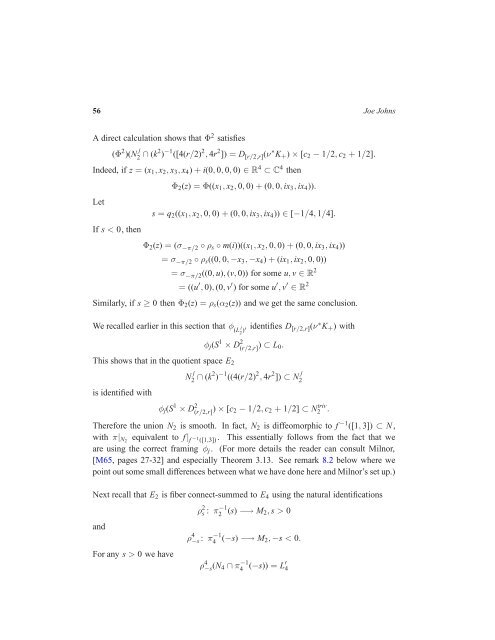The Picard-Lefschetz theory of complexified Morse functions 1 ...
The Picard-Lefschetz theory of complexified Morse functions 1 ...
The Picard-Lefschetz theory of complexified Morse functions 1 ...
You also want an ePaper? Increase the reach of your titles
YUMPU automatically turns print PDFs into web optimized ePapers that Google loves.
56 Joe Johns<br />
A direct calculation shows that Φ 2 satisfies<br />
(Φ 2 )(N j<br />
2 ∩ (k2 ) −1 ([4(r/2) 2 , 4r 2 ]) = D [r/2,r](ν ∗ K+) × [c2 − 1/2, c2 + 1/2].<br />
Indeed, if z = (x1, x2, x3, x4) + i(0, 0, 0, 0) ∈ R 4 ⊂ C 4 then<br />
Let<br />
If s < 0, then<br />
Φ2(z) = Φ((x1, x2, 0, 0) + (0, 0, ix3, ix4)).<br />
s = q2((x1, x2, 0, 0) + (0, 0, ix3, ix4)) ∈ [−1/4, 1/4].<br />
Φ2(z) = (σ −π/2 ◦ ρs ◦ m(i))((x1, x2, 0, 0) + (0, 0, ix3, ix4))<br />
= σ −π/2 ◦ ρs((0, 0, −x3, −x4) + (ix1, ix2, 0, 0))<br />
= σ −π/2((0, u), (v, 0)) for some u, v ∈ R 2<br />
= ((u ′ , 0), (0, v ′ ) for some u ′ , v ′ ∈ R 2<br />
Similarly, if s ≥ 0 then Φ2(z) = ρs(α2(z)) and we get the same conclusion.<br />
We recalled earlier in this section that φ (L j<br />
2 )′ identifies D [r/2,r](ν ∗ K+) with<br />
This shows that in the quotient space E2<br />
is identified with<br />
φj(S 1 × D 2 (r/2,r] ) ⊂ L0.<br />
N j<br />
2 ∩ (k2 ) −1 ((4(r/2) 2 , 4r 2 ]) ⊂ N j<br />
2<br />
φj(S 1 × D 2 (r/2,r] ) × [c2 − 1/2, c2 + 1/2] ⊂ N triv<br />
2 .<br />
<strong>The</strong>refore the union N2 is smooth. In fact, N2 is diffeomorphic to f −1 ([1, 3]) ⊂ N ,<br />
with π|N2 equivalent to f | f −1 ([1,3]). This essentially follows from the fact that we<br />
are using the correct framing φj . (For more details the reader can consult Milnor,<br />
[M65, pages 27-32] and especially <strong>The</strong>orem 3.13. See remark 8.2 below where we<br />
point out some small differences between what we have done here and Milnor’s set up.)<br />
Next recall that E2 is fiber connect-summed to E4 using the natural identifications<br />
and<br />
For any s > 0 we have<br />
ρ 2 s : π −1<br />
2 (s) −→ M2, s > 0<br />
ρ 4 −s : π −1<br />
4 (−s) −→ M2, −s < 0.<br />
ρ 4 −s (N4 ∩ π −1<br />
4 (−s)) = L′ 4
















